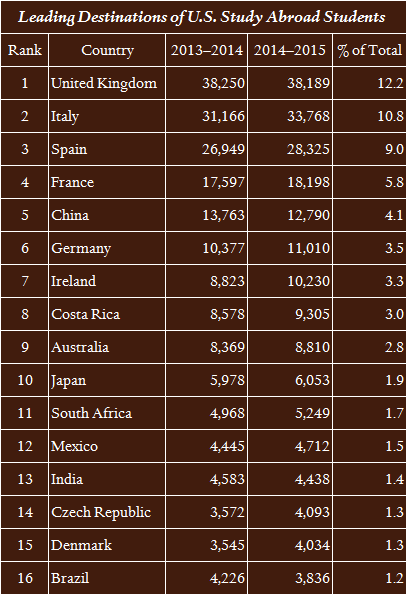More on:
This is International Education Week, an opportunity for the U.S. Department of State and the Department of Education to promote study abroad. As the State Department press release puts it, the week will emphasize “encouraging Americans and international students alike to seek opportunities to study abroad, make connections with peers in other countries, and ultimately to see themselves as actors in and shapers of both their local communities and a globalized future.” The State Department has also announced a partnership with Diversity Abroad to “work toward diversifying participation in international education overall.”
Here’s my advice for the U.S. government and for higher education in general: it’s time to actively diversify as well the idea of “abroad,” because for a plurality of American students, “abroad” appears to mean the United Kingdom (UK), Italy, and Spain. These are beautiful countries and terrific places to visit. But if a central reason to encourage study abroad lies in better preparing American youth for a world of global competition, we’d do much better incentivizing knowledge and familiarity with the world’s rising powers. I can think of no better time to do that than during a college semester or year abroad. Sadly, the data tells a different story.
More than 300,000 American students studied abroad during 2014–15, the most recent year for which the Institute for International Education’s annual Open Doors report tabulated data. The UK, Italy, and Spain serve as the destination for 32 percent of U.S. students abroad. Things drop precipitously after that, with France, China, Germany, Costa Rica, and Australia combined accounting for a little more than 22 percent, and then a long tail of countries which as destinations hover between 1 and 2 percent of the total.
China does comparatively well here, as the fifth most sought-after destination. South Africa is number 11, India number 13, Brazil number 16, and Russia does not crack the top 25 with only 1,187 study abroad Americans. This means that all the BRICS (Brazil, Russia, India, China, South Africa) countries combined still host fewer Americans studying abroad (27,500) than does Spain (28,325).
As it has for every year I have tracked this data, India fares poorly. With 4,438 study abroad Americans, India hosts fewer than half that head to Ireland or to Costa Rica. The number who head to India has steadily ticked up over the years—in 2001–02 fewer than 650 U.S. students selected India as a destination—but its showing by comparison with other countries does not align with India’s growing global role. India looks more like the Czech Republic or like Mexico in study abroad numbers.

I recognize that students have many choices before them in how to spend their limited time. And far more programs exist to facilitate a semester in Western Europe than have been in place for India and other less–selected countries. (Anecdotally, I am always surprised to see how comparatively few students head to Japan, one of the world’s largest economies and one with ample study abroad programs.) But in my view, our national preparedness would be better served to see a larger percentage of students heading to the BRICS countries, or to the “CIVETS” (Colombia, Indonesia, Vietnam, Egypt, Turkey, South Africa) or MIKTs (Mexico, Indonesia, South Korea, Turkey) or any other acronym describing emerging markets or rising major economies. This year’s International Education Week carries the theme, “empowering youth through international education.” American youth would be even more empowered to gain significant exposure to the countries shaping the future they will live in.
Top photo credit: Photo by Daniel Oerther licensed under CC-BY-4.0.
Follow me on Twitter: @AyresAlyssa. Or like me on Facebook (fb.me/ayresalyssa) or Instagram (instagr.am/ayresalyssa).
More on:
 Online Store
Online Store

